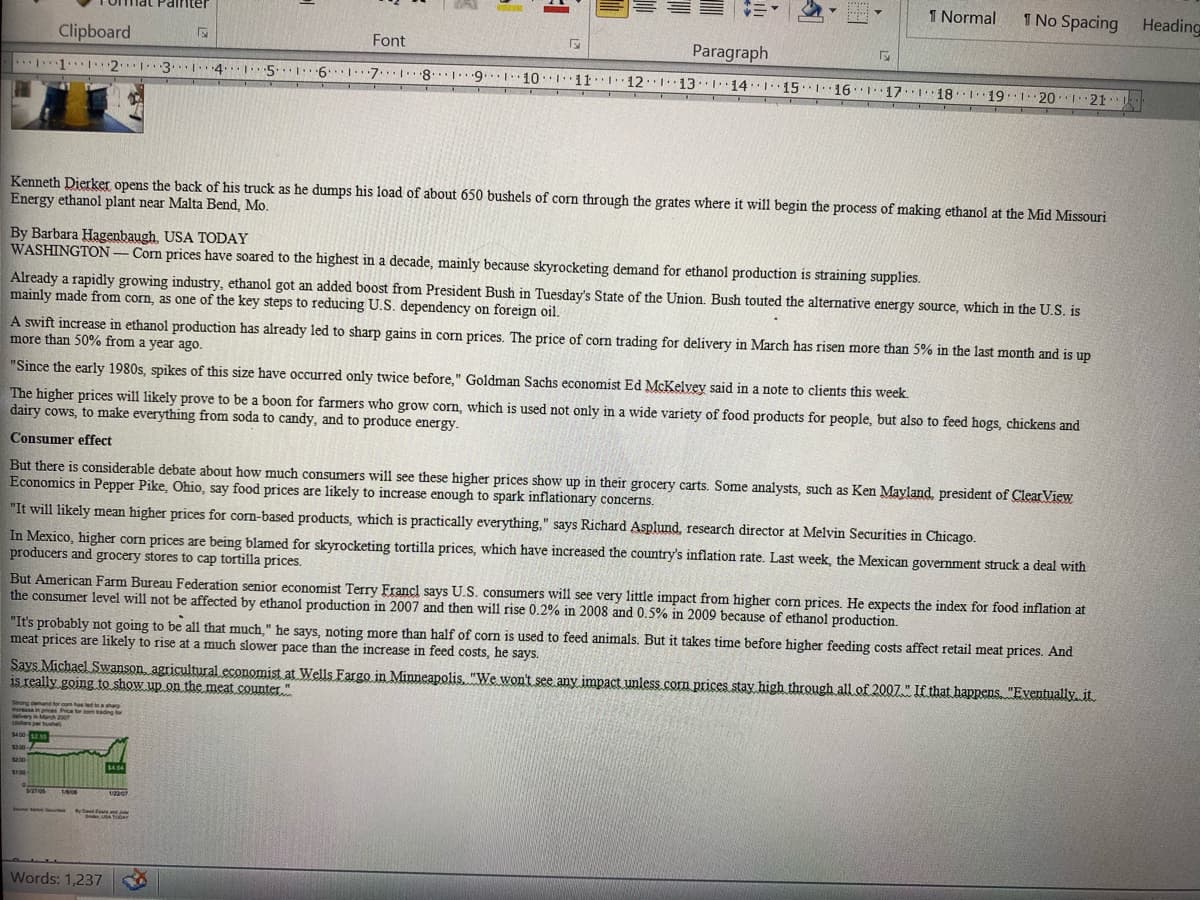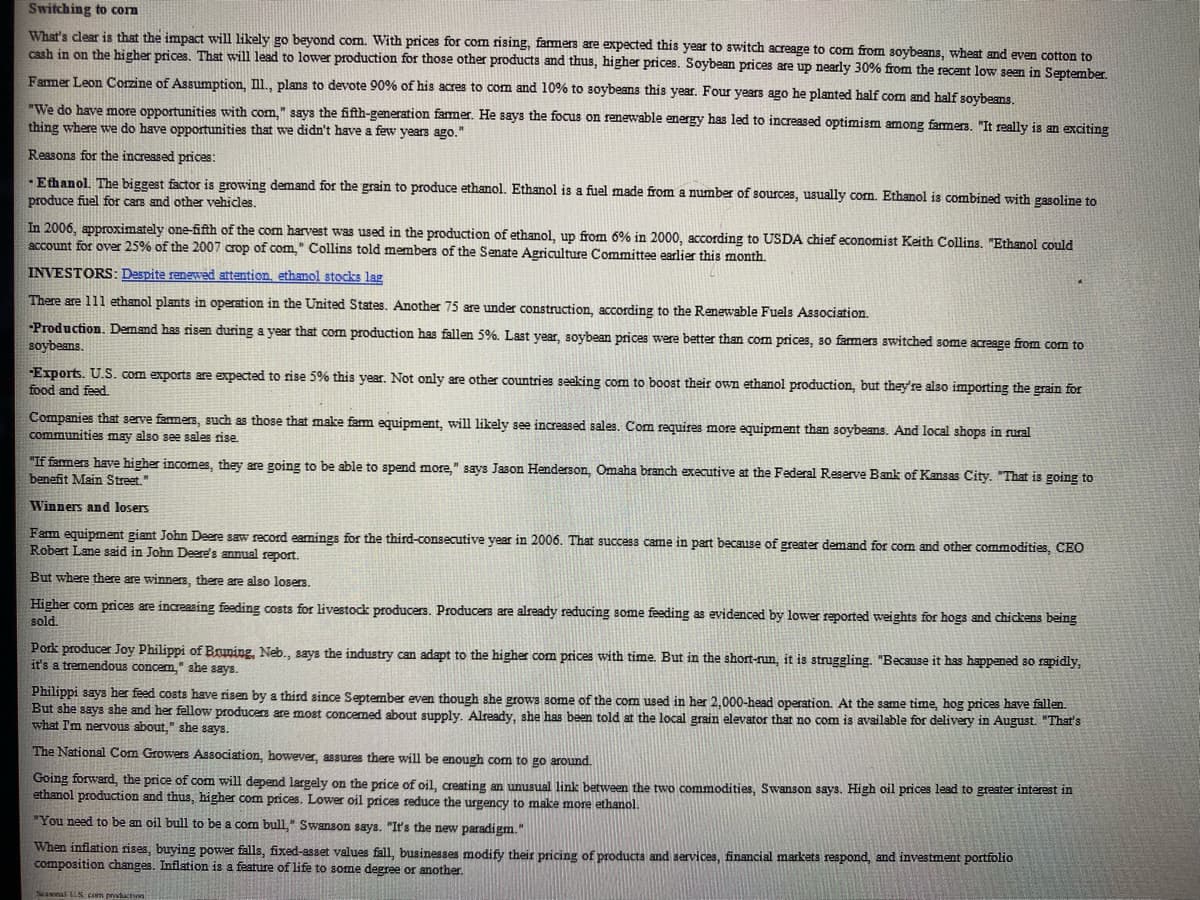Please draw two graphs The first graph showing the impact of higher corn prices on (consumers) explain which curve will shift on the graph and change in price and quantity of demand On the second graph the same thing but for (producers) If you can please also explain the impact of higher corn prices on consumers and producers..
Please draw two graphs The first graph showing the impact of higher corn prices on (consumers) explain which curve will shift on the graph and change in price and quantity of demand On the second graph the same thing but for (producers) If you can please also explain the impact of higher corn prices on consumers and producers..
Chapter7: Uncertainty
Section: Chapter Questions
Problem 7.8P
Related questions
Question
Please draw two graphs
The first graph showing the impact of higher corn prices on (consumers) explain which curve will shift on the graph and change in price and quantity of demand
On the second graph the same thing but for (producers)
If you can please also explain the impact of higher corn prices on consumers and producers..
Thank you so much for your time and patience !!

Transcribed Image Text:1 Normal
1 No Spacing Heading
Tnat Painter
Clipboard
Font
Paragraph
1 213
7.. 8. 9... 10111112113114 I 151161171 181191 20I 21
....
.....
191 20121
Kenneth Dierker opens the back of his truck as he dumps his load of about 650 bushels of corn through the grates where it will begin the process of making ethanol at the Mid Missouri
Energy ethanol plant near Malta Bend, Mo.
By Barbara Hagenbaugh. USA TODAY
WASHINGTON-Com prices have soared to the highest in a decade, mainly because skyrocketing demand for ethanol production is straining supplies.
Already a rapidly growing industry, ethanol got an added boost from President Bush in Tuesday's State of the Union. Bush touted the alternative energy source, which in the U.S. is
mainly made from corn, as one of the key steps to reducing U.S. dependency on foreign oil.
A swift increase in ethanol production has already led to sharp gains in corn prices. The price of corm trading for delivery in March has risen more than 5% in the last month and is up
more than 50% from a year ago.
"Since the early 1980s, spikes of this size have occurred only twice before," Goldman Sachs economist Ed McKelyey said in a note to clients this week.
The higher prices will likely prove to be a boon for farmers who grow corn, which is used not only in a wide variety of food products for people, but also to feed hogs, chickens and
dairy cows, to make everything from soda to candy, and to produce energy.
Consumer effect
But there is considerable debate about how much consumers will see these higher prices show up in their grocery carts. Some analysts, such as Ken Mayland, president of ClearView
Economics in Pepper Pike, Ohio, say food prices are likely to increase enough to spark inflationary concerns.
"It will likely mean higher prices for corn-based products, which is practically everything," says Richard Asplund, research director at Melvin Securities in Chicago.
In Mexico, higher com prices are being blamed for skyrocketing tortilla prices, which have increased the country's inflation rate. Last week, the Mexican government struck a deal with
producers and grocery stores to cap tortilla prices.
But American Farm Bureau Federation senior economist Terry Francl says U.S. consumers will see very little impact from higher com prices. He expects the index for food inflation at
the consumer level will not be affected by ethanol production in 2007 and then will rise 0.2% in 2008 and 0.5% in 2009 because of ethanol production.
"It's probably not going to be all that much" he says, noting more than half of com is used to feed animals. But it takes time before higher feeding costs affect retail meat prices. And
meat prices are likely to rise at a much slower pace than the increase in feed costs, he says.
Says Michael Swanson agricultural economist at Wells Fargo in Minneapolis. "We won't see any impact unless.com prices stay high through all of 2007." If that happens "Eventually, it.
is really going to show up .on the meat .counter."
Strong emand for co has led to shar
Price or com ading lor
ease
elvery in March 2007
dars per bushel
$400 5
$300-
s200
$4.04
S100
1/220
A ToGAY
Words: 1,237

Transcribed Image Text:Switching to com
What's clear is that the impact will likely go beyond com. With prices for com rising, farmers are expected this year to switch acreage to com from soybeans, wheat and even cotton to
cash in on the higher prices. That will lead to lower production for those other products and thus, higher prices. Soybean prices are up nearly 30% from the recent low seen in September.
Famer Leon Corzine of Assumption, Ill., plans to devote 90% of his acres to com and 10% to soybeans this year. Four years ago he planted half com and half soybeans,
"We do have more opportunities with com," says the fifth-generation farmer. He says the focus on renewable energy has led to increased optimism among farmers. "It really is an exciting
thing where we do have opportunities that we didn't have
few years ago."
Reasons for the increased prices:
- Ethanol. The biggest factor is growing demand for the grain to produce ethanol. Ethamol is a fuel made from a number of sources, usually com. Ethanol is combined with gasoline to
produce fuel for cars and other vehicles.
In 2006, approximately one-fifth of the com harvest was used in the production of ethanol, up from 6% in 2000, according to USDA chief economist Keith Collins, "Ethanol could
account for over 25% of the 2007 crop of com," Collins told members of the Senate Agriculture Committee earlier this month.
INVESTORS: Despite renewed attention, ethanol stocks lag
There are 111 ethanol plants in operation in the United States. Another 75 are under construction, according to the Renewable Fuels Association.
-Production. Demand has risen during a year that com production has fallen 5%. Last year, soybean prices were better than com prices, so farmers switched some acreage from com to
soybeans.
-Exports. U.S. com exports are expected to rise 5% this year. Not only are other countries seeking com to boost their own ethanol production, but they're also importing the grain for
food and feed.
Companies that serve farmers, such as those that make farm equipment, will likely see increased sales. Com requires more equipment than soybeans. And local shops in rural
communities may also see sales rise.
"If farmer
have higher incomes, they are going to be able to spend more," says Jason Henderson, Omaha branch executive at the Federal Reserve Bank of Kansas City. "That is going to
benefit Main Street."
Winners and losers
Farm equipment giant John Deere saw record eamings for the third-consecutive year in 2006. That success came in part because of greater demand for com and other commodities, CEO
Robert Lane said in John Deere's annual report.
But where there are winner, there are also losers.
Higher com prices are increasing feeding costs for livestock producers. Producers are already reducing some feeding as evidenced by lower reported weights for hogs and chickens being
sold.
Pork producer Joy Philippi of Brming, Neb., says the industry can adapt to the higher com prices with time. But in the short-run, it is struggling. "Because it has happened so rapidly,
it's a tremendous concem," she aays.
Philippi says her feed costs have risen by a third since September even though she grows some of the com used in her 2,000-head operation. At the same time, hog prices have fallen.
But she says she and her fellow producers are most concemed about supply. Already, she has been told at the local grain elevator that no com is available for delivery in August. "That's
what I'm nervous about," she says.
The National Com Growers Association, however, assures there will be enough com to go around.
Going forward, the price of com will depend largely on the price of oil, creating an unusual link between the two commodities, Swanson says. High oil prices lead to greater interest in
ethanol production and thus, higher com prices. Lower oil prices reduce the urgency to make more ethanol.
"You need to be an oil bull to be a com bull," Swanson says. "It's the new paradigm."
When inflation rises, buying power falls, fixed-asset values fall, businesses modify their pricing of products and services, financial markets respond, and investment portfolio
composition changes. Inflation is a feature of life to some degree or another.
Seawal LS com prodaction
Expert Solution
This question has been solved!
Explore an expertly crafted, step-by-step solution for a thorough understanding of key concepts.
This is a popular solution!
Trending now
This is a popular solution!
Step by step
Solved in 3 steps with 3 images

Knowledge Booster
Learn more about
Need a deep-dive on the concept behind this application? Look no further. Learn more about this topic, economics and related others by exploring similar questions and additional content below.Recommended textbooks for you


Principles of Microeconomics
Economics
ISBN:
9781305156050
Author:
N. Gregory Mankiw
Publisher:
Cengage Learning

Principles of Economics 2e
Economics
ISBN:
9781947172364
Author:
Steven A. Greenlaw; David Shapiro
Publisher:
OpenStax


Principles of Microeconomics
Economics
ISBN:
9781305156050
Author:
N. Gregory Mankiw
Publisher:
Cengage Learning

Principles of Economics 2e
Economics
ISBN:
9781947172364
Author:
Steven A. Greenlaw; David Shapiro
Publisher:
OpenStax